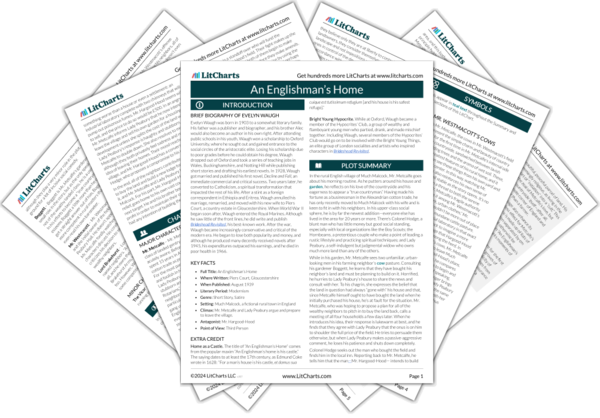Mr. Metcalfe’s long-awaited acceptance into the cult of “true countrymen” at the end of “An Englishman’s Home” highlights the characteristics that the story implies truly unify the English gentry: pride, pettiness, and spite. In the beginning of the story, Mr. Metcalfe desperately tries and fails to emulate what he believes to be the markers of a country gentleman, studying aphorisms, choosing outfits, and pulling plants—all to no avail. Nothing he tries seems to gain him entry into his neighbors’ social club until he finally loses his patience, gives up, and initiates a power struggle with Lady Peabury in passive aggressive letters. After he contributes a large sum of money to the erection of the Scouts’ lodge, Mr. Metcalfe is finally able to cross the invisible boundary between himself and his neighbors and join the ranks of the country gentry. At the story’s close, his momentum even begins to threaten the most established inhabitant of Much Malcock, Lord Brakehurst, as he donates enough money to change the name of the local inn from “The Brakehurst Arms” to “The Metcalfe Arms.” Ironically, it ends up being the same cotton money that initially set Mr. Metcalfe apart from his neighbors that ultimately greases his way into the fold—they used to condescendingly make fun of his new-money wealth by calling him a “cotton wallah,” but his money from the cotton trade eventually allows him to maneuver his way into a position of social prominence. With the conclusion of the story, Waugh satirizes the arbitrariness of minor social boundaries between members of the obscenely wealthy upper class. Between the liberal Hornbeams and the conservative Colonel Hodge, the gentlewoman Lady Peabury and the businessman Mr. Metcalfe, what unites the elite neighbors of Much Malcock and facilitates Mr. Metcalfe’s inclusion is not even their desire to improve their community so much as their arrogant sense of self-importance.
Social Mobility ThemeTracker

Social Mobility Quotes in An Englishman’s Home
For Metcalfe was but lately initiated into the cult of the countryside, and any features of it still claimed his devotion—its agricultural processes, its social structure, its vocabulary, its recreations; the aspect of it, glittering now under the cool May sunshine, fruit trees in flower, chestnut in full leaf, the ash budding; the sound and smell of it—Mr. Westmacott calling his cows at dawn, the scent of wet earth and Boggett splashing clumsily among the wall-flowers; the heart of it—or what Mr. Metcalfe took to be its heart—pulsing all round him; his own heart beating time, for was he not part of it, a true countryman, a landowner?
Lady Peabury lived at Much Malcock House, whose chimneys, soon to be hidden in the full foliage of summer, could still be seen among its budding limes on the opposite slope of the valley[…]. She was a widow and, like Mr. Metcalfe, had come to Much Malcock from abroad.
Colonel Hodge lived at the Manor […] whose gardens, too, backed on to Westmacott’s meadow. He was impecunious but active in the affairs of the British Legion and the Boy Scouts; he accepted Mr. Metcalfe’s invitation to dinner, but spoke of him, in his family circle, as “the cotton wallah.”
[…] the Hornbeams at the Old Mill were a childless, middle-aged couple who devoted themselves to craftsmanship. Mr. Hornbeam senior was a genuine commercial potter in Staffordshire; he supported them reluctantly and rather exiguously, but this backing of unearned quarterly cheques placed them definitely in the upper strata of local society […]. Mr. Metcalfe thought Mr. Hornbeam Bohemian, and Mr. Hornbeam thought Mr. Metcalfe Philistine.
There was a sudden change. He was no longer the public-spirited countryman; he was cards-on-the-table-brass-tacks-and-twenty-shillings-in-the-pound-treat-him-fair-or-mind-your-step Metcalfe, Metcalfe with his back up, fighting Metcalfe once again, Metcalfe who would cut off his nose any day to spite his face, sink any ship for a ha’p’orth of tar that was not legally due, Metcalfe the lion of the Rotarians.











